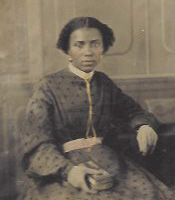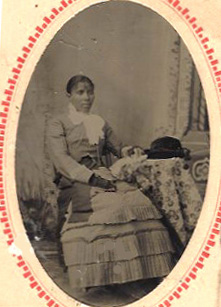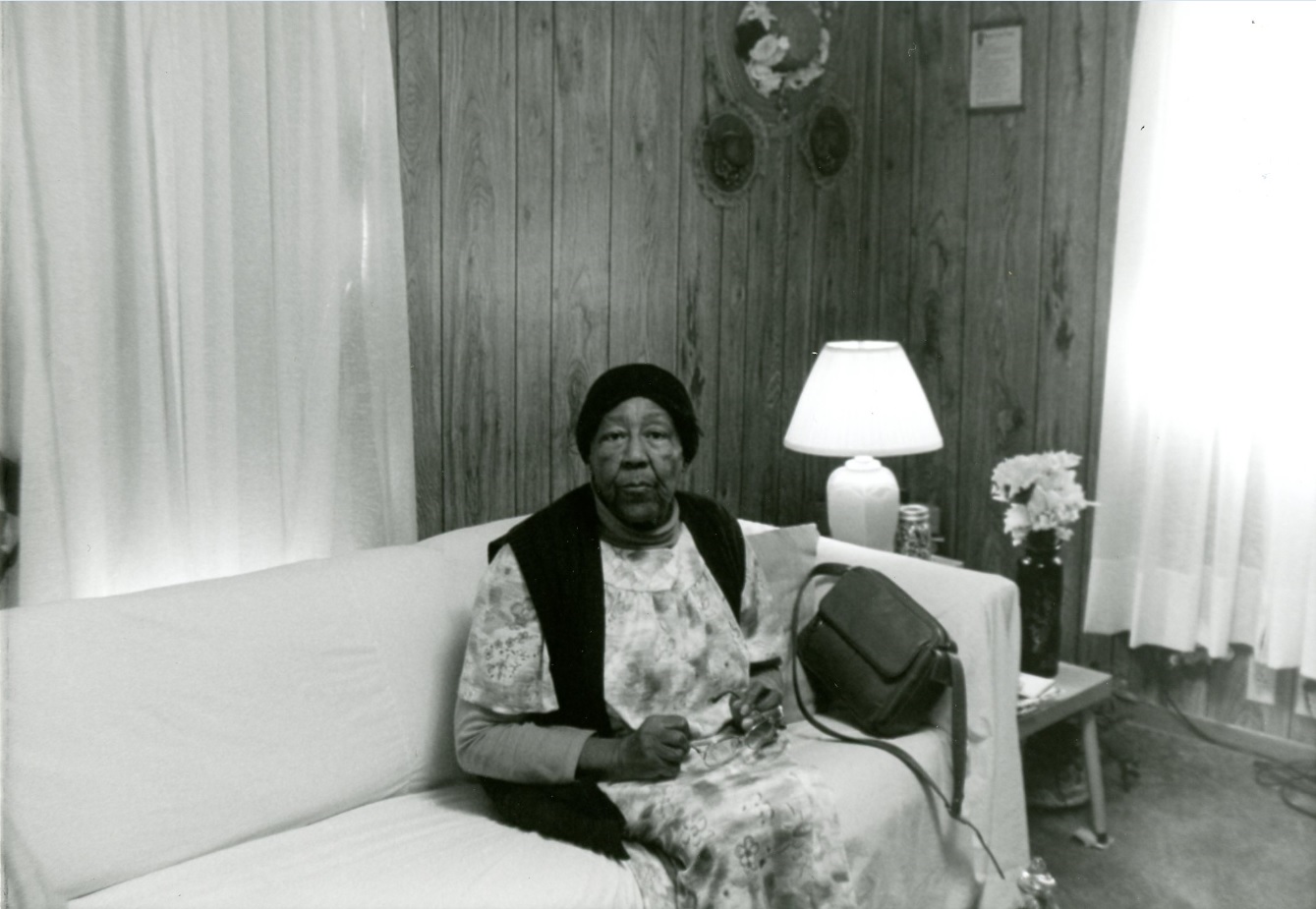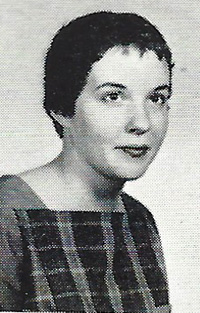Timothy Smith from the University of Tennessee at Martin was the featured speaker in WKU Libraries’ “Kentucky Live series” on Thursday, March 8, at Barnes & Noble Bookstore in Bowling Green. His topic was “Civil War Battlefield Preservation in History, Memory, and Policy.” The talk concluded with book signing.
Kentucky Live! presents Timothy B. Smith, “Altogether Fitting and Proper: Civil War Battlefield Preservation in History, Memory, and Policy”
Comments Off on Kentucky Live! presents Timothy B. Smith, “Altogether Fitting and Proper: Civil War Battlefield Preservation in History, Memory, and Policy”
Filed under Events, General, Kentucky Live, Latest News, People
“Please Tell Me. . .”
It was a gargantuan undertaking, but for decades Jackson Clinton Van Meter (“J.C.”) labored toward his goal: to compile a history of the Van Meter family in America. The old Dutch clan gained a foothold in the New World in the 17th century, when pioneer Jan Joosten Van Meteren arrived with his wife and five children and began to accumulate property in New York and New Jersey. By the early twentieth century, J.C. estimated that there were about 20,000 Van Meter kinfolk to track down.
From his Edmonson County, Kentucky home, J.C. searched diligently for Van Meters and members of related families, sending letters to them all over the country and asking them to supply detailed information about their ancestry. “Please Tell Me:” was at the head of his preprinted, fill-in-the-blanks questionnaire that asked the subject to begin with his/her grandfather and supply names, dates, birthplaces, occupations, professed religion, marriages, children, and so on. J.C. would also type out tailor-made questionnaires, particularly where he was in need of certain information or the recipient had failed to supply a full genealogy. New contacts gleaned from one subject would lead to a fresh round of letters and questionnaires. In addition, J.C. vacuumed up data from other researchers of the same family lines and incorporated it into his collection.
To encourage his subjects to participate, J.C. had a unique selling point: somewhere back in the mists of time, the Van Meter family had married into the mysterious Hedges family. Legend had it that one Charles Hedges died in England leaving some $269 million to a nephew who had emigrated to America. The inheritance lay unclaimed in the Bank of England while the Van Meters and Hedges multiplied across the ocean, but J.C. theorized that if all the present-day heirs could be proven and the results presented to the Bank, the massive fortune could finally be distributed.
Hmmm. We’ve seen this before. And while we can’t conclude that J.C. believed the Hedges estate to be genuine (it wasn’t), it still allowed him and many, many Van Meters to fantasize about hitting the jackpot…and, incidentally, it generated a mass of genealogy, now held in the Manuscripts & Folklife Archives of WKU’s Library Special Collections. Click here to access a finding aid. For more family research collections, search TopSCHOLAR and KenCat.
Comments Off on “Please Tell Me. . .”
Filed under Manuscripts & Folklife Archives
Abel, Boyd, and Kuykendall
In 1900, James E. Kuykendall (1874-1960), an African-American native of Butler County, Kentucky, opened a funeral home at 819 State Street in Bowling Green. For more than 50 years, he served the city’s African-American population both alone and in partnership with James A. Boyd. In the 1930s, brothers Francis and Richard Abel established Abel Brothers, which also served the same constituents.
The records of these historic African-American businesses were later placed with Gatewood and Sons Funeral Chapel, and copies are held in the Manuscripts & Folklife Archives of WKU’s Department of Library Special Collections. Dating from 1900-1970, they provide data about funeral dates and expenses, but some are useful genealogical resources because they provide additional information about the deceased such as occupation, cause of death, parents’ names, and place of interment. Also included with these records is a listing of interments in Mt. Moriah, Bowling Green’s African-American cemetery.
A finding aid for these funeral home records can be accessed here. For more collections on funeral homes and other businesses, search TopSCHOLAR and KenCat.
Comments Off on Abel, Boyd, and Kuykendall
Filed under Manuscripts & Folklife Archives
Sophia
She was, by his description, a “little mulatto girl” he first encountered in 1867 during his military duty at Little Rock, Arkansas. Their ensuing 22-year relationship was neither simple nor ordinary, but the story of Sophia and Captain Richard Vance, a native of Warren County, Kentucky, is preserved in Vance’s diaries, now part of the Manuscripts & Folklife Archives of WKU’s Department of Library Special Collections. The only thing missing from the story, sadly, is the voice of Sophia herself.
Separated from her family and cast adrift after her emancipation from slavery, Sophia, no more than sixteen years old, seemed doomed to become the sexual plaything of the officers in Vance’s garrison. Indeed, that may have been how Vance himself, who frequented local prostitutes to satisfy his need for a woman’s “delicious embraces,” initially regarded her. But he soon found himself “desperately stuck on my little girl”– my “new flame”– and when Sophia’s principal patron abandoned her, she became his servant and mistress.
Though completely smitten, Vance was fearful that his “dangerous experiment” would be discovered. Nevertheless, neither he nor Sophia were inclined to end the relationship, and he was relieved in 1869 when he managed to bring her along to his new posting at Baton Rouge, Louisiana. In 1876, they were at Fort Dodge, Kansas, where Sophia married and departed, Vance assumed, for a new life. Before long, however, both Sophia and her husband George returned and took up the care of his household. Throughout Vance’s subsequent duty in the Indian Territory, Colorado and Texas, they turned his military lodgings into a comfortable home, anchored his life, and eased his restlessness and unhappiness with the Army. When Henry, a young boy abandoned to Sophia’s care, joined the household, an odd but strangely durable family unit was created.
Everything changed late in 1888, when Vance returned to Fort Clark, Texas from a lengthy trip to find Sophia ill. He had been wearily searching for a place to retire and had even purchased a farm near Washington, D.C., but was torn between bringing Sophia, George and Henry into his post-Army life or making a clean break. Only after watching in anguish as Sophia sank and died in May 1889 did he understand what he had lost. His diary entry cried out simply: I am in a world of trouble. Sophia.
Wandering from place to place in retirement, Vance routinely turned his thoughts back to his years with Sophia. “Those were my best and happiest days,” he wrote, “the like of which I must not expect to see again, for there was but one Sophia.” On a January morning in 1893, he found the scene outside his lodgings so reminiscent of “the prospect from the back window of the last quarters I occupied in Ft. Clark that I can easily fancy that I have but to go below to find Sophia busying about some household duty; to find Henry playing with his toys in the yard; to find the dogs lazily dozing in the wood shed; and all the paraphernalia of my old establishment.” For Vance, who never married, Sophia represented a golden age that he had failed to appreciate and to which he could never return.
Click here for a finding aid to the Richard Vance Collection. For more collections search TopSCHOLAR and KenCat.
Comments Off on Sophia
Filed under Manuscripts & Folklife Archives
Within the All of It: Trigg County African-American Oral History Project
“What I told you is what your grandparents tried to tell me: that this is your country, that this is your world, that this is your body, and you must find some way to live within the all of it.”
Ta-Nehisi Coates, Between the World and Me
In the fall of 1995, four folk studies students from the Cultural Conservation class at WKU conducted an oral history project to document African American heritage in Caldwell, Christian, Todd, and Trigg counties. With grant-based funding from the Pennyrile Area Development District (PADD), local committees were established in each county, allowing interviewers to become better acquainted with long-time residents and their personal narratives, which focused on their experiences of living in Trigg County.
The student group recorded a total of 18 interviews with 15 participants, most of whom have longstanding familial ties to the region. The interviews, which often take the format of a “life history,” cover a broad range of topics from American Bandstand, sorority life, courtship customs, and bootlegging, to tobacco harvesting, family reunions, quilting bees, and church services. The scope of the project, spanning nearly five decades from the early 1900s to the late 1950s, marks an era of both agricultural and industrial growth, political uncertainty, and technological advancement—all nipping at the heels of the stirring civil rights movement.
Serving as the first oral history project of its kind in Trigg County, the lives of its participants are played out on tape in ways that reveal what it meant to be black in the Jim Crow South, how physical landscapes shape cultural traditions, and how a strong sense of identity was—and remains—crucial in developing supportive, lasting communities.
The collection itself (FA 196), located within WKU’s Manuscripts and Folklife Archives, contains photographs of participants, brief biographical sketches, original interview cassette tapes, and detailed indexes of every recorded interview.
For information on African American experiences in Kentucky, Trigg County, and additional oral history projects, visit TopSCHOLAR or browse through KenCat, a searchable database featuring manuscripts, photographs and other non-book objects housed in the Department of Library Special Collections!
Post written by WKU Folk Studies graduate student Delainey Bowers
Comments Off on Within the All of It: Trigg County African-American Oral History Project
Filed under Manuscripts & Folklife Archives, People
Far Away Places presents Nancy Rice on “The Magic, Mystery and Misfortune of Modern Kenya”

WKU Biologist Nancy Rice talked about “The Magic, Mystery, and Misfortune of Modern Kenya” in WKU Libraries’ Far Away Places series on Thursday, February 22 at Barnes & Noble Bookstore.
Comments Off on Far Away Places presents Nancy Rice on “The Magic, Mystery and Misfortune of Modern Kenya”
Filed under Uncategorized
State Street High School
One of the prized holdings in the Department of Library Special Collections is the 1951 Mustang, the yearbook of the State Street High School. The State Street School served this area’s African-American students starting in 1883; High Street school took its place in 1955.
Edward Tipton Buford, known as E.T. Buford, was the principal of the school and is featured in this yearbook. He made a tremendous impact on many students in this region and state. He was born in 1894 in Giles County, TN and earned a bachelor’s degree from Fisk University and a Master’s degree from Indiana University. He served as principal of State Street and High Street schools from 1924 to 1964. Like many other African American educators, during the time of segregation and limited resources, it was said that “Buford developed an advanced curriculum, got the school accredited, recruited highly educated teachers and secured needed resources.”
Some other African American teachers in Warren County were Robert Barlow, Christine Barlow, Ethel Buford, Virginia Cabell, Lula Carpenter, Clara Cole, Addie J. Edmonds, Lutisha Frierson, Willie Gossom, Lena Hudson, C. A. Hutcherson, Latter Huston Cox, Eva Kuykendall, Lila Bell Lee, Frances Luvalle, Charity McCrutchen, Emma Milligan, Mabel Moore, Frank Moxley, Claude Nichols, Alroma Nichols, Mattie Patticord, A. L. Poole, Ethel Ray, A. P. Williams, Delorese Williams, Clara Bell Yarbrough, and Henry Yost.
Click here to see this yearbook; search for other yearbooks at WKU One Search box.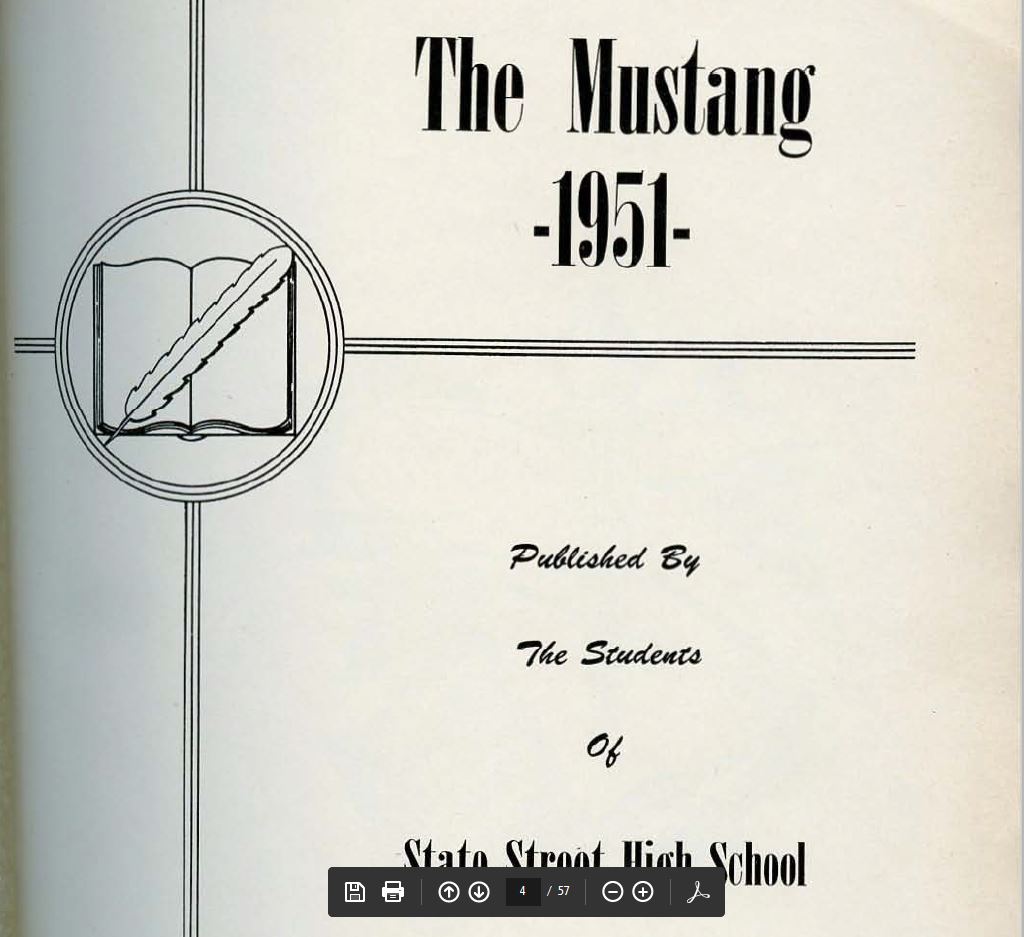 Contact Special Collections at 270-745-5083 or spcol@wku.edu
Contact Special Collections at 270-745-5083 or spcol@wku.edu
Comments Off on State Street High School
Filed under Uncategorized
Kentucky Live! presents Mary Ellen Pethel, “College Life and the Making of Modern Nashville”
Kentucky Live! Presented Mary Ellen Pethel on College Life and the Making of Modern Nashville on Thursday, February 15, 2018 at Barnes & Noble Bookstore (1680 Campbell Lane).
Comments Off on Kentucky Live! presents Mary Ellen Pethel, “College Life and the Making of Modern Nashville”
Filed under Events, Kentucky Live, Latest News, People
Drakes Creek Middle School receives WKU Libraries School Library Grant
Bowling Green, Kentucky – Drakes Creek Middle School Library was recognized on Thursday, January 25 for being this year’s winner for the School Library Grant sponsored by the Friends of WKU Libraries. This is the fourth year WKU Libraries has offered the grant to schools in the Barren River Area Development District.
The grant is made possible with funds from Friends of WKU Libraries and is given out to one middle or high school annually with different purposes, including improving collections or technology, for professional development funds, to improve students’ research skills, and to offer reading enrichment opportunities.
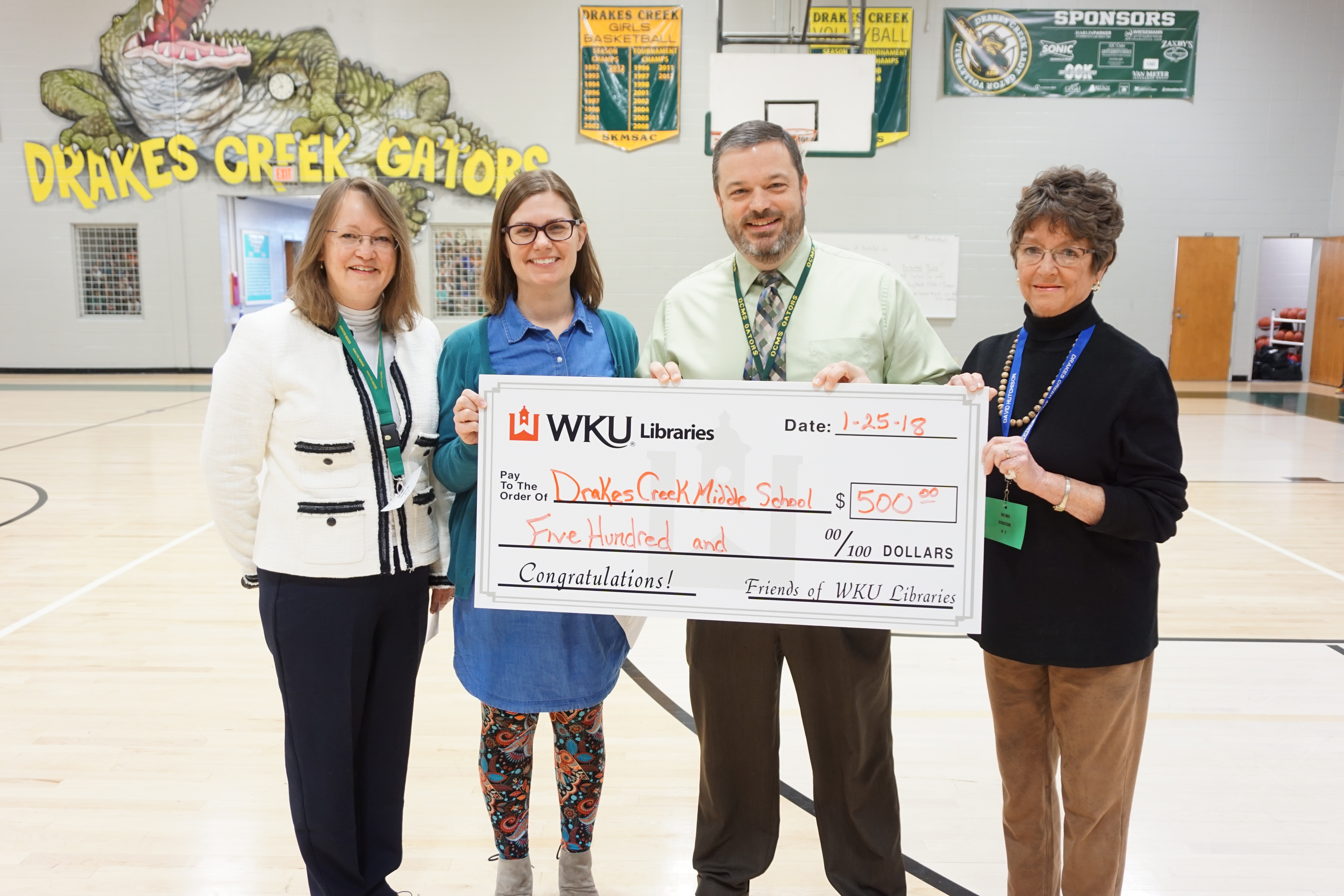
Renee Hale is the Library Media Specialist who wrote the winning application for the school. According to Hale, the grant money will be used to improve the technology of the library by creating a Green Screen studio for students to create and edit video projects.
“The video projects will encourage hands-on, creative application of thinking,” said Hale. “We are thrilled to be able to offer this to our students.”
WKU Libraries Dean Susann deVries, Library Advisory Council Chair Nancy Priest, and WKU Libraries Communications Coordinator Jennifer Wilson attended the school’s morning meeting to make the announcement to the entire student body and present the check for $500 to Ms. Hale and Principal Daryl Woods. For more information about the grant, contact jennifer.wilson@wku.edu.
Comments Off on Drakes Creek Middle School receives WKU Libraries School Library Grant
Filed under General, Latest News
She Got to “Y”
Novelist Sue Grafton published her first “alphabet” mystery, A is For Alibi, in 1982. At the time of her death in December 2017, the native of Louisville, Kentucky had penned 25 best-selling titles, most recently Y is for Yesterday, and both Grafton and Kinsey Millhone, her fictional “hard-boiled” female detective and heroine of the series, had earned a worldwide following. Grafton had long known that her finale, slated to appear in fall 2019, would be called Z is for Zero.
In 2000, with her 15th book complete and many more yet to be conceived, Grafton told an interviewer that “thinking about the rest of the alphabet was apoplexy-inducing.” But three years later, she was still on course, as she told a fan. “I’m currently at work on ‘R’ IS FOR . . . which has a title that’s known only to me,” she wrote. Ten chapters were done, but she believed it was better “to wait until the story’s laid out so I can make sure the title is appropriate.” Though she confessed that “each book seems harder to write than the one before,” Grafton hoped her correspondent would “follow me all the way ’til ‘Z’ IS FOR ZERO.”
Sue Grafton’s letter to one of her many fans is part of the Manuscripts & Folklife Archives of WKU’s Department of Library Special Collections. Click here for a finding aid. For more collections on Kentucky authors, search TopSCHOLAR and KenCat.
Comments Off on She Got to “Y”
Filed under Manuscripts & Folklife Archives




